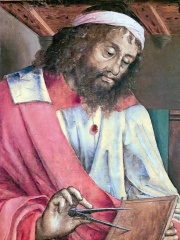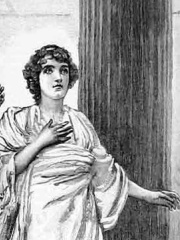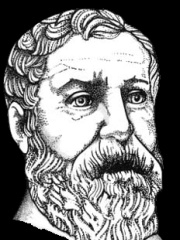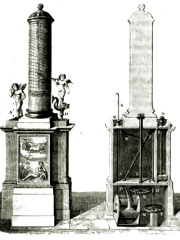







The Most Famous
MATHEMATICIANS from Egypt
This page contains a list of the greatest Egyptian Mathematicians. The pantheon dataset contains 823 Mathematicians, 11 of which were born in Egypt. This makes Egypt the birth place of the 17th most number of Mathematicians behind Netherlands and Norway.
Top 10
The following people are considered by Pantheon to be the top 10 most legendary Egyptian Mathematicians of all time. This list of famous Egyptian Mathematicians is sorted by HPI (Historical Popularity Index), a metric that aggregates information on a biography’s online popularity. Visit the rankings page to view the entire list of Egyptian Mathematicians.

1. Euclid (-350 - -240)
With an HPI of 83.48, Euclid is the most famous Egyptian Mathematician. His biography has been translated into 150 different languages on wikipedia.
Euclid (; Greek: Εὐκλείδης; fl. 300 BC) was an ancient Greek mathematician active as a geometer and logician. Considered the "father of geometry", he is chiefly known for the Elements treatise, which established the foundations of geometry that largely dominated the field until the early 19th century. His system, now referred to as Euclidean geometry, involved new innovations in combination with a synthesis of theories from earlier Greek mathematicians, including Eudoxus of Cnidus, Hippocrates of Chios, Thales and Theaetetus. With Archimedes and Apollonius of Perga, Euclid is generally considered among the greatest mathematicians of antiquity, and one of the most influential in the history of mathematics. Very little is known of Euclid's life, and most information comes from the scholars Proclus and Pappus of Alexandria many centuries later. Medieval Islamic mathematicians invented a fanciful biography, and medieval Byzantine and early Renaissance scholars mistook him for the earlier philosopher Euclid of Megara. It is now generally accepted that he spent his career in Alexandria and lived around 300 BC, after Plato's students and before Archimedes. There is some speculation that Euclid studied at the Platonic Academy and later taught at the Musaeum; he is regarded as bridging the earlier Platonic tradition in Athens with the later tradition of Alexandria. In the Elements, Euclid deduced the theorems from a small set of axioms. He also wrote works on perspective, conic sections, spherical geometry, number theory, and mathematical rigour. In addition to the Elements, Euclid wrote a central early text in the optics field, Optics, and lesser-known works including Data and Phaenomena. Euclid's authorship of On Divisions of Figures and Catoptrics has been questioned. He is thought to have written many lost works.

2. Hypatia (350 - 415)
With an HPI of 81.91, Hypatia is the 2nd most famous Egyptian Mathematician. Her biography has been translated into 90 different languages.
Hypatia (born c. 350–370; died 415 AD) was a Neoplatonist philosopher, astronomer, and mathematician who lived in Alexandria, Egypt, then part of the Eastern Roman Empire. She was a prominent thinker in Alexandria where she taught philosophy and astronomy. Although preceded by Pandrosion, another Alexandrian female mathematician, she is the first female mathematician whose life is reasonably well recorded. Hypatia was renowned in her own lifetime as a great teacher and a wise counselor. She wrote a commentary on Diophantus's thirteen-volume Arithmetica, which may survive in part, having been interpolated into Diophantus's original text, and another commentary on Apollonius of Perga's treatise on conic sections, which has not survived. Many modern scholars also believe that Hypatia may have edited the surviving text of Ptolemy's Almagest, based on the title of her father Theon's commentary on Book III of the Almagest. Hypatia constructed astrolabes and hydrometers, but did not invent either of these, which were both in use long before she was born. She was tolerant toward Christians and taught many Christian students, including Synesius, the future bishop of Ptolemais. Ancient sources record that Hypatia was widely beloved by pagans and Christians alike and that she established great influence with the political elite in Alexandria. Toward the end of her life, Hypatia advised Orestes, the Roman prefect of Alexandria, who was in the midst of a political feud with Cyril, the bishop of Alexandria. Rumors spread accusing her of preventing Orestes from reconciling with Cyril and, in March 415 AD, she was murdered by a mob of Christians led by a lector named Peter. Hypatia's murder shocked the empire and transformed her into a "martyr for philosophy", leading future Neoplatonists such as the historian Damascius (c. 458 – c. 538) to become increasingly fervent in their opposition to Christianity. During the Middle Ages, Hypatia was co-opted as a symbol of Christian virtue and scholars believe she was part of the basis for the legend of Saint Catherine of Alexandria. During the Age of Enlightenment, she became a symbol of opposition to Catholicism. In the nineteenth century, European literature, especially Charles Kingsley's 1853 novel Hypatia, romanticized her as "the last of the Hellenes". In the twentieth century, Hypatia became seen as an icon for women's rights and a precursor to the feminist movement. Since the late twentieth century, some portrayals have associated Hypatia's death with the destruction of the Library of Alexandria, despite the historical fact that the library no longer existed during Hypatia's lifetime.

3. Diophantus (201 - 300)
With an HPI of 75.97, Diophantus is the 3rd most famous Egyptian Mathematician. His biography has been translated into 67 different languages.
Diophantus of Alexandria (born c. AD 200 – c. 214; died c. AD 284 – c. 298) was a Greek mathematician, who was the author of two main works: On Polygonal Numbers, which survives incomplete, and the Arithmetica in thirteen books, most of it extant, made up of arithmetical problems that are solved through algebraic equations. Diophantus was the first Greek mathematician who recognized positive rational numbers as numbers, by allowing fractions for coefficients and solutions. He coined the term παρισότης (parisotes) to refer to an approximate equality. This term was rendered as adaequalitas in Latin, and became the technique of adequality developed by Pierre de Fermat to find maxima for functions and tangent lines to curves. Although not the earliest, the Arithmetica has the best-known use of algebraic notation to solve arithmetical problems coming from Greek antiquity, and some of its problems served as inspiration for later mathematicians working in analysis and number theory. In modern use, Diophantine equations are algebraic equations with integer coefficients for which integer solutions are sought. Diophantine geometry and Diophantine approximations are two other subareas of number theory that are named after him.

4. Hero of Alexandria (10 - 75)
With an HPI of 75.56, Hero of Alexandria is the 4th most famous Egyptian Mathematician. His biography has been translated into 67 different languages.
Hero of Alexandria (; Greek: Ἥρων ὁ Ἀλεξανδρεύς, Hērōn hò Alexandreús, also known as Heron of Alexandria ; fl. 60 AD) was a Greek mathematician and engineer who was active in his native city of Alexandria in Egypt during the Roman era. He is often considered the greatest experimenter of antiquity and his work is representative of the Hellenistic scientific tradition. Hero published a well-recognized description of a steam-powered device called an aeolipile (sometimes called a "Hero engine"). Among his most famous inventions was a windwheel, constituting the earliest instance of wind harnessing on land. He is said to have been a follower of the atomists. In his work Mechanics, he described pantographs. Some of his ideas were derived from the works of Ctesibius. In mathematics he is mostly remembered for Heron's formula, a way to calculate the area of a triangle using only the lengths of its sides. Much of Hero's original writings and designs have been lost, but some of his works were preserved including in manuscripts from the Eastern Roman Empire and to a lesser extent, in Latin or Arabic translations.

5. Ctesibius (-284 - -221)
With an HPI of 67.01, Ctesibius is the 5th most famous Egyptian Mathematician. His biography has been translated into 37 different languages.
Ctesibius or Ktesibios or Tesibius (Greek: Κτησίβιος; fl. 285–222 BC) was a Greek inventor and mathematician in Alexandria, Ptolemaic Egypt. He wrote the first treatises on the science of compressed air and its uses in pumps (and even in a kind of cannon). This, in combination with his work On pneumatics on the elasticity of air, earned him the title of "father of pneumatics." None of his written work has survived, including his Memorabilia, a compilation of his research that was cited by Athenaeus. Ctesibius' most commonly known invention today is a pipe organ (hydraulis), a predecessor of the modern church organ.

6. Pappus of Alexandria (290 - 350)
With an HPI of 66.98, Pappus of Alexandria is the 6th most famous Egyptian Mathematician. His biography has been translated into 46 different languages.
Pappus of Alexandria (; Greek: Πάππος ὁ Ἀλεξανδρεύς; c. 290 – c. 350 AD) was a Greek mathematician of Late Antiquity known for his Synagoge (Συναγωγή) or Collection (c. 340), and for Pappus's hexagon theorem in projective geometry. Almost nothing is known about his life except for what can be found in his own writings, many of which are lost. Pappus apparently lived in Alexandria were he worked as a mathematics teacher to higher level students, such one named Hermodorus. The Collection, his best-known work, is a compendium of mathematics in eight volumes, the bulk of which survives. It covers a wide range of topics that were part of the ancient mathematics curriculum, including geometry, astronomy, and mechanics. Pappus was active in a period generally considered one of stagnation in mathematical studies, where he stands out as a remarkable exception. In many respects, his fate strikingly resembles that of Diophantus', originally of limited importance but becoming very influential in the late Renaissance and Early Modern periods.

7. Theon of Alexandria (335 - 405)
With an HPI of 63.80, Theon of Alexandria is the 7th most famous Egyptian Mathematician. His biography has been translated into 27 different languages.
Theon of Alexandria (; Ancient Greek: Θέων ὁ Ἀλεξανδρεύς; c. AD 335 – c. 405) was a Greek scholar and mathematician who lived in Alexandria, Egypt. He edited and arranged Euclid's Elements and wrote commentaries on works by Euclid and Ptolemy. His daughter Hypatia also won fame as a mathematician.

8. Menelaus of Alexandria (70 - 140)
With an HPI of 62.42, Menelaus of Alexandria is the 8th most famous Egyptian Mathematician. His biography has been translated into 23 different languages.
Menelaus of Alexandria (; Greek: Μενέλαος ὁ Ἀλεξανδρεύς, Menelaos ho Alexandreus; c. 70 – 140 CE) was a Greek mathematician and astronomer, the first to recognize geodesics on a curved surface as natural analogs of straight lines.

9. Ahmes (-1680 - -1620)
With an HPI of 60.42, Ahmes is the 9th most famous Egyptian Mathematician. His biography has been translated into 24 different languages.
Ahmes (Ancient Egyptian: jꜥḥ-ms “, a common Egyptian name also transliterated Ahmose) was an ancient Egyptian scribe who lived towards the end of the Fifteenth Dynasty (and of the Second Intermediate Period) and the beginning of the Eighteenth Dynasty (and of the New Kingdom). He transcribed the Rhind Mathematical Papyrus, a work of ancient Egyptian mathematics that dates to approximately 1550 BC; he is the earliest contributor to mathematics whose name is known. Ahmes claimed not to be the writer of the work but rather just the scribe. He claimed the material came from an even older document from around 2000 B.C.

10. Ibn Yunus (950 - 1009)
With an HPI of 59.74, Ibn Yunus is the 10th most famous Egyptian Mathematician. His biography has been translated into 30 different languages.
Abu al-Hasan 'Ali ibn Abi al-Said 'Abd al-Rahman ibn Ahmad ibn Yunus ibn Abd al-'Ala al-Sadafi al-Misri (Egyptian Arabic: ابن يونس; c. 950 – 1009) was an important Egyptian astronomer and mathematician, whose works are noted for being ahead of their time, having been based on meticulous calculations and attention to detail. He is one of the famous Muslim astronomers who appeared after Al-Battani and Abu al-Wafa' al-Buzjani, and he was perhaps the greatest astronomer of his time. Because of his brilliance, the Fatimids gave him generous gifts and established an observatory for him on Mount Mokattam near Fustat. Al-Aziz Billah ordered him to make astronomical tables, which he completed during the reign of Al-Hakim bi-Amr Allah, son of Al-Aziz, and called it al-Zij al-Kabir al-Hakimi. The crater Ibn Yunus on the Moon is named after him.
Pantheon has 11 people classified as mathematicians born between 1680 BC and 950. Of these 11, none of them are still alive today. The most famous deceased mathematicians include Euclid, Hypatia, and Diophantus.
Deceased Mathematicians
Go to all Rankings
Euclid
350 BC - 240 BC
HPI: 83.48
Hypatia
350 - 415
HPI: 81.91
Diophantus
201 - 300
HPI: 75.97
Hero of Alexandria
10 - 75
HPI: 75.56
Ctesibius
284 BC - 221 BC
HPI: 67.01
Pappus of Alexandria
290 - 350
HPI: 66.98
Theon of Alexandria
335 - 405
HPI: 63.80
Menelaus of Alexandria
70 - 140
HPI: 62.42
Ahmes
1680 BC - 1620 BC
HPI: 60.42
Ibn Yunus
950 - 1009
HPI: 59.74
Abū Kāmil Shujāʿ ibn Aslam
850 - 930
HPI: 55.21







